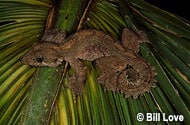Description:
A small, taller-than-wide tank will suffice for this denizen of wet forests of southeastern Asia. Despite their name, flying geckos don’t need enough space to glide about in captivity. In fact, just the opposite is true. You don’t want them to launch and end up smashing against the opposite side of their cage. Place some smooth-barked logs vertically so the flying geckos can climb and hide amongst them. The flying geckos’ cryptic skin helps them virtually disappear – an effective form of camouflage they’ll amaze you with when you try to locate them in a cage decorated as described. Mist the logs and glass thoroughly at least every other day to maintain a high humidity in the cage at night, but don’t make it so wet that it doesn’t dry out again by day. You want to create humidity, but not dampness and stagnancy. Offer a variety of small insects several times per week, but be sure not to overfeed so the bug population builds up in the cage. Although nocturnal geckos don’t bask in the standard way, placing a tiny light bulb above one corner of the cage allows a warm spot if the flying gecko decides to use it.
Habitat:
Forests and manmade structures
Range:
Southeast Asia
Scientific Name: Ptychozoon kuhli
Species Group: gecko
Family: Gekkonidae
Size: 4 to 7 inches
Level: intermediate
Weight:
Dangerous: No



